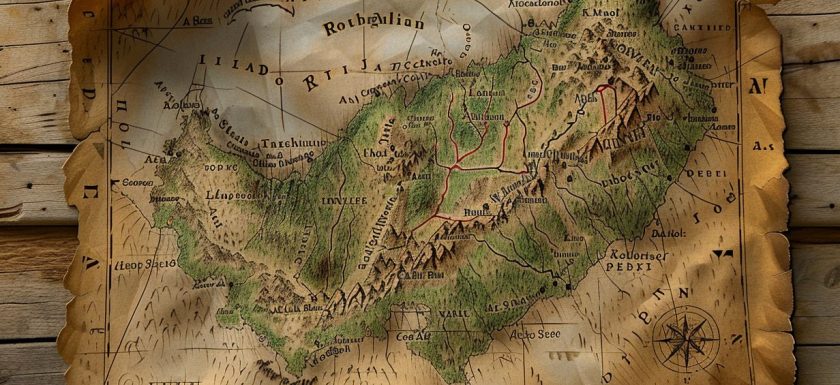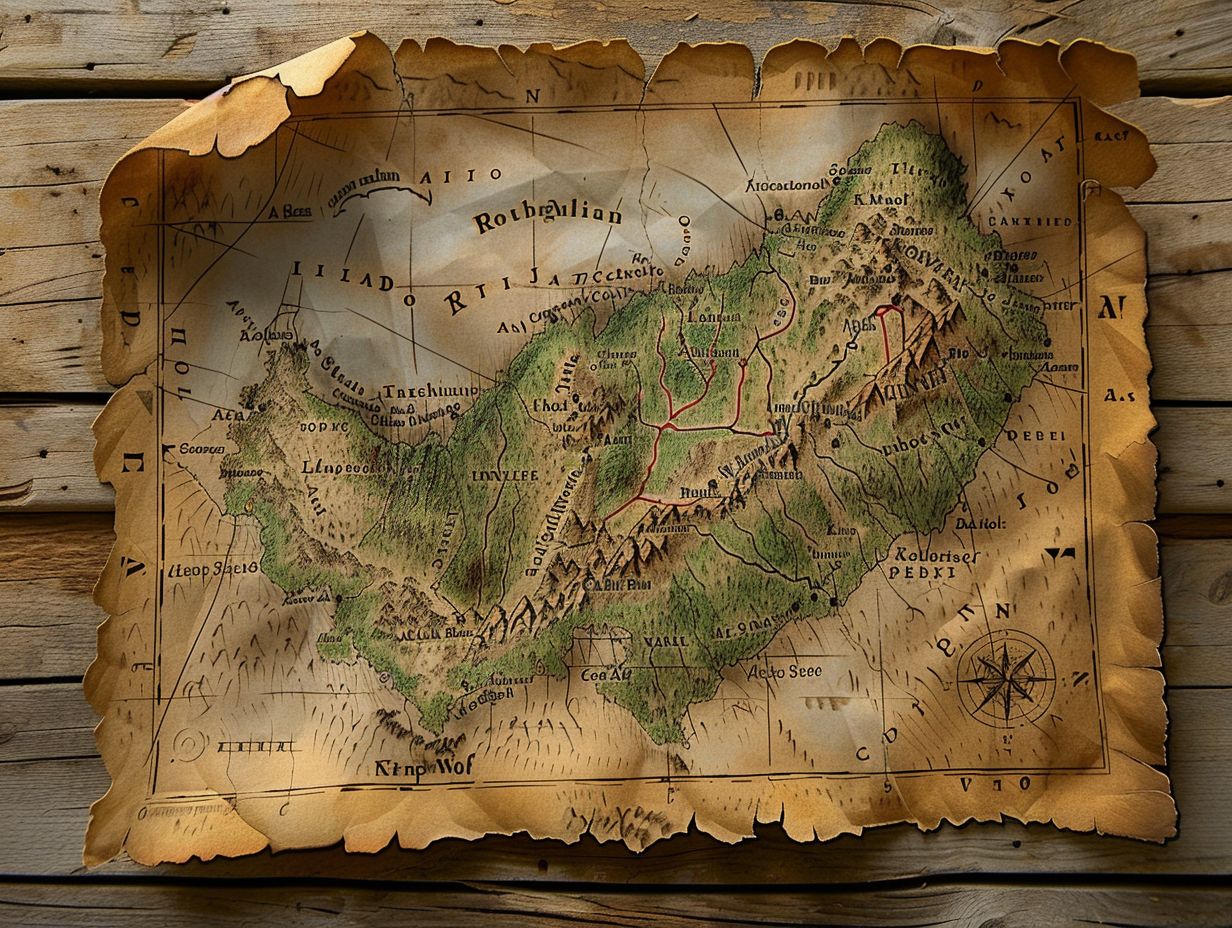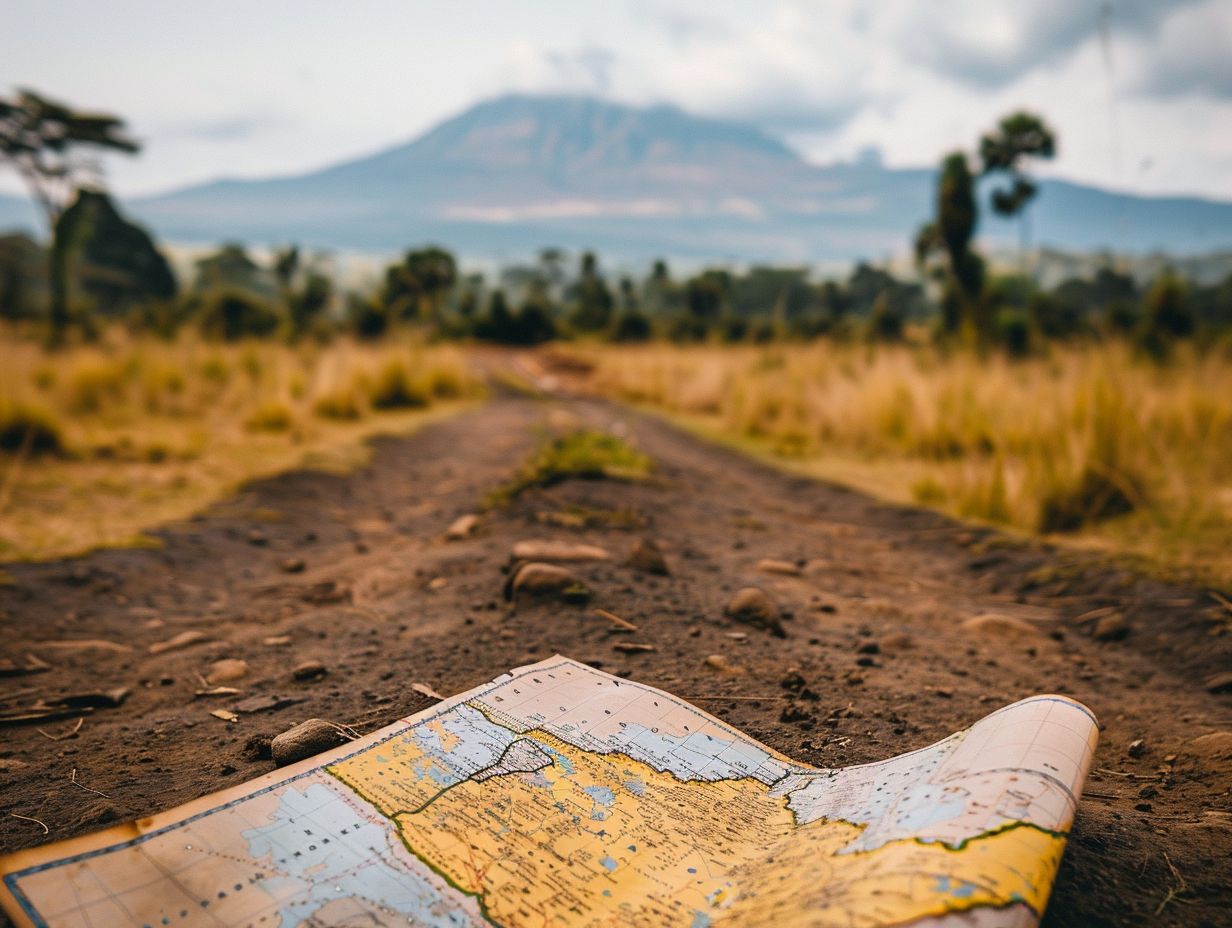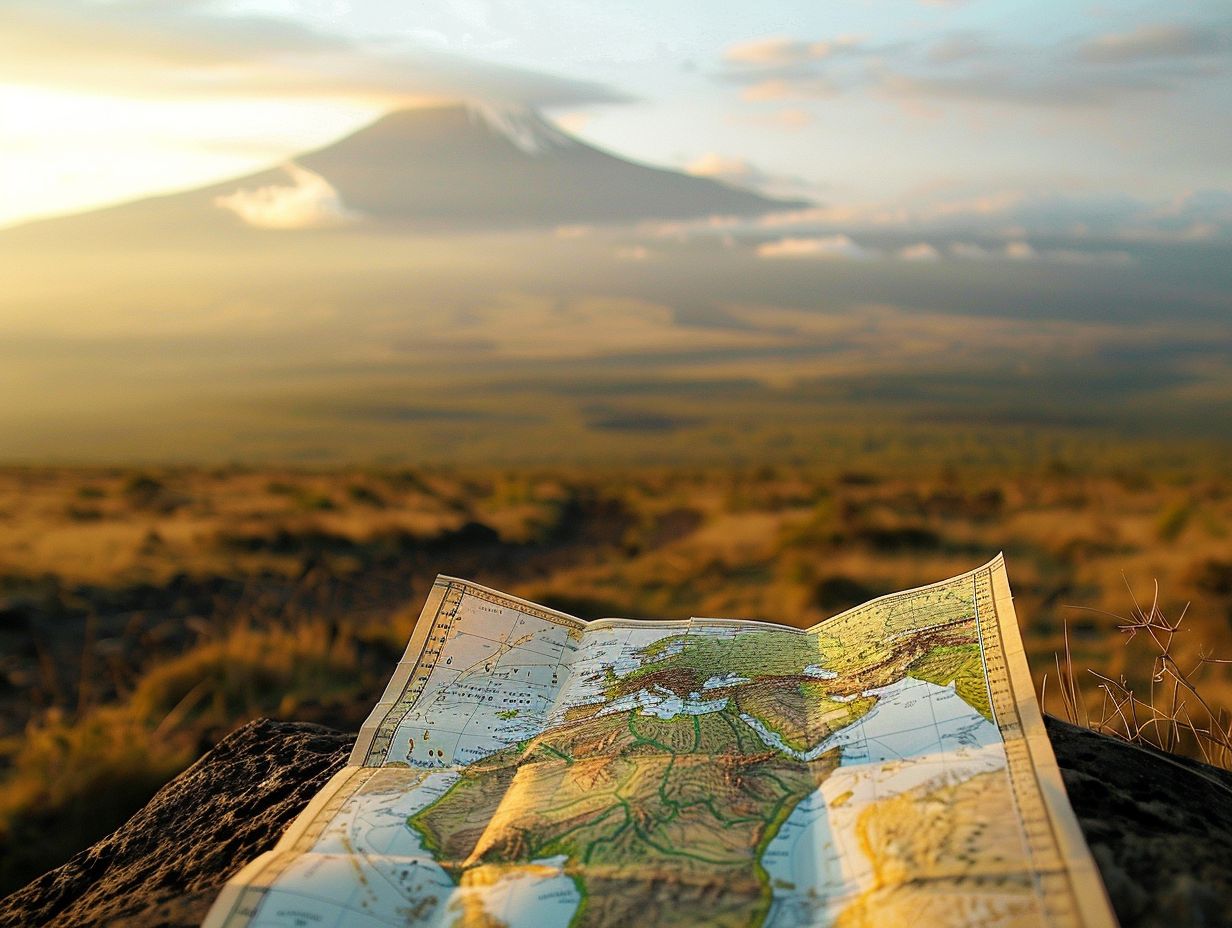
In this detailed guide, we will explore everything you need to know to make your adventure a reality. From the best time to climb Kilimanjaro to the different routes available, we will cover it all.
Discover the physical and gear requirements, potential risks and how to prepare both physically and mentally for this ultimate challenge.
Get ready for the journey of a lifetime to the roof of Africa!
Key Takeaways:
- Kilimanjaro is located in Tanzania, Africa and is the highest mountain in the continent.
- The best time to climb Kilimanjaro is during the dry season from July to September.
- The most popular route to climb Kilimanjaro is the Marangu route, while the most challenging route is the Lemosho route.
Where is Kilimanjaro Located?

Kilimanjaro is located in Tanzania, a country in East Africa known for its diverse wildlife and stunning landscapes, specifically in the Mount Kilimanjaro National Park.
Standing at approximately 19,341 feet (5,895 meters) above sea level, Kilimanjaro is the highest peak in Africa and attracts adventurers and nature enthusiasts from all around the globe. Its remarkable height and distinct snow-capped peak make it a prominent feature in the African landscape.
Designated as a UNESCO World Heritage Site, Kilimanjaro holds immense cultural and ecological significance, providing a home to a variety of plant and animal species that are unique to this region.
What is the Best Time to Climb Kilimanjaro?
The best time to climb Kilimanjaro is during the dry seasons, typically from late June to October and from late December to mid-March, when the weather conditions are more favorable for trekking.
During these periods, the weather on Mount Kilimanjaro is generally clear, with less chance of rain and snow, providing trekkers with excellent visibility and a safer climbing experience. The temperatures are also more moderate, making it more comfortable for climbers to navigate the diverse terrains of the mountain.
The dry seasons coincide with the peak climbing months, attracting more experienced and novice climbers alike, enhancing the camaraderie and support among fellow trekkers.
What is the Weather Lik
e in Kilimanjaro?
Weather conditions in Kilimanjaro undergo significant changes in temperature and precipitation levels as climbers ascend the mountain, ranging from tropical conditions at the base to arctic conditions at the summit.
These temperature shifts are affected by the diverse climate zones on Kilimanjaro, such as the rainforest, moorland, alpine desert, and arctic summit, each presenting its distinct weather patterns, which add complexity and variety to the ascent.
Seasonal changes also play a role in Kilimanjaro’s weather, with noticeable distinctions between the dry seasons (from June to October) and the wet seasons (from November to May).
During the dry season, climbers can expect clear skies and sunny weather, while the wet season brings more precipitation and cloud cover, impacting visibility and trail conditions.
What are the Different Routes to Climb Kilimanjaro?
There are several routes to climb Kilimanjaro, each offering unique challenges and scenic views, such as the Lemosho Route, Machame Route, Marangu Route, Rongai Route and the Northern Circuit.
Among these, the Lemosho Route stands out for its gradual ascent, providing ample time for acclimatization and increasing the chances of a successful summit bid.
The Machame Route, known as the ‘Whiskey Route‘ offers a more challenging climb, with steeper ascents and descents through varying landscapes of lush rainforest and alpine desert.
The Marangu Route, often dubbed the ‘Coca-Cola Route’ is popular for its straightforward paths and hut accommodations.
In contrast, the Rongai Route on Kilimanjaro’s northern side provides a quieter, more remote experience showcasing a different perspective of the mountain.
For those seeking a longer and more comprehensive trek, the Northern Circuit encompasses diverse terrains and abundant wildlife sightings along the less crowded northern slopes, making it a favorite for adventurers looking for a unique Kilimanjaro experience.
Which Route is the Most Popular?
The Machame Route is considered the most popular route for climbing Kilimanjaro due to its scenic beauty, diverse landscapes, and relatively high success rates among trekkers.
Featuring stunning views of Mt. Kilimanjaro’s glaciers and volcanic peaks, this route has gained fame for its picturesque scenery that ranges from lush rainforests to barren alpine deserts.
Trekkers are drawn to the challenge of its steep ascent through various ecological zones, offering an immersive experience in the diverse flora and fauna of the region.
Although demanding, the Machame Route is known for providing trekkers with ample acclimatization opportunities, increasing the chances of reaching the summit. Its longer duration compared to other routes allows hikers to adjust better to altitude changes, reducing the risk of altitude sickness.
Which Route is the Most Challenging?

The Western Breach Route is renowned as one of the most challenging routes to climb Kilimanjaro requiring technical skills, experience, and acclimatization to tackle its steep terrain and high altitude sections.
What adds to the difficulty of the Western Breach Route is the unpredictable weather conditions that can change rapidly, exposing climbers to extreme cold, high winds, and potential snowstorms.
Altitude sickness poses a significant risk due to the quick ascent to the crater rim. Adequate preparation is essential including physical conditioning, proper gear, and mental readiness to face the physical and mental demands.
The route demands a strategic approach with careful navigation through loose scree and rocks requiring concentration and agility to overcome its technical challenges.
What are the Requirements for Climbing Kilimanjaro?
Climbing Kilimanjaro requires physical fitness, mental preparedness, proper gear, permits and a qualified guide to ensure a safe and successful trek to the summit.
Before embarking on the journey to conquer Kilimanjaro, it’s crucial to be in the good physical condition as the trek demands stamina and endurance to traverse varying terrains and altitudes.
Adequate equipment such as sturdy hiking boots, layered clothing, a reliable backpack, and essential supplies like water and energy snacks are essential for the long journey ahead.
Obtaining the necessary permits is a non-negotiable step to comply with park regulations and ensure your entry to the mountain.
Having experienced guides and a supporting team is vital, offering expertise, security, and assistance throughout the challenging expedition.
What are the Physical Requirements?
Physical fitness is crucial for climbing Kilimanjaro as trekkers need to endure long hours of hiking varying altitudes and challenging terrains while carrying their gear.
Endurance becomes a key factor as climbers navigate steep slopes and rocky paths, often facing unpredictable weather conditions.
Building strength and stamina is essential for handling the rigorous demands of the trek, which can last several days. Trekkers must be prepared to face physical challenges like fatigue, muscle soreness, and altitude sickness requiring a high level of physical resilience.
What Gear is Needed for Climbing Kilimanjaro?
Essential gear for climbing Kilimanjaro includes proper hiking boots, trekking poles, thermal clothing, a warm sleeping bag, and high-altitude gear to combat the harsh conditions on the mountain.
To successfully conquer Kilimanjaro, you’ll also need a sturdy backpack for carrying supplies, a reliable headlamp for early morning starts and night treks, and a hydration system to ensure you stay well-hydrated throughout the climb. Crampons and ice axes are crucial for navigating steep icy sections.
Proper acclimatization aids such as Diamox can help prevent altitude sickness, making your ascent more comfortable and safer.
Don’t forget sunscreen and lip balm for UV protection, as well as a first aid kit for emergencies on the trail. Packing light but efficiently is key to a manageable climb.
What are the Potential Risks and Dangers of Climbing Kilimanjaro?
Climbing Kilimanjaro poses risks such as altitude sickness, extreme weather conditions, and encounters with wildlife that trekkers need to be prepared for and mitigate during their ascent.
Altitude-related illnesses, such as acute mountain sickness, high-altitude pulmonary edema, and high-altitude cerebral edema, can be major concerns for climbers due to the rapid elevation gain.
These conditions can cause symptoms ranging from nausea and headaches to more severe effects like confusion and fluid in the lungs or brain. Adventurers must acclimatize properly, stay hydrated, and recognize warning signs to prevent serious health complications at higher altitudes.
- Altitude Sickness
Altitude sickness, also known as acute mountain sickness (AMS), is a common risk for climbers ascending Kilimanjaro due to the rapid gain in elevation, leading to symptoms like headaches, nausea, and fatigue.
Altitude sickness on Kilimanjaro is primarily caused by the decreased air pressure and lower oxygen levels as climbers ascend to higher altitudes.
These environmental changes can result in the body struggling to acclimatize quickly, leading to AMS symptoms. Climbers may experience shortness of breath, dizziness, and loss of appetite, further complicating the ascent.
To prevent altitude sickness, gradual acclimatization is essential. Climbers should also stay properly hydrated, maintain a steady pace and consider medications like acetazolamide under medical supervision. In severe cases, descending to lower altitudes is crucial for effective treatment of altitude sickness.”
Weather Conditions

Weather conditions on Kilimanjaro can range from scorching heat at the base to freezing temperatures at the summit with rapid changes in weather patterns that pose challenges to climbers throughout their ascent.
At lower elevations, climbers may face intense sun exposure and high temperatures, making proper hydration crucial.
As climbers ascend, temperatures drop significantly, and the air becomes thinner, demanding careful acclimatization.
Temperature fluctuations can be extreme, with nights bringing frosty conditions even amid a hot day. Precipitation levels vary from dry to heavy snowfalls, turning the landscape into a winter wonderland at higher altitudes.
Climbers must be prepared for sudden climatic shifts that can impact visibility and route conditions.
Wildlife
Kilimanjaro’s slopes are home to a variety of wildlife species, including colobus monkeys, elephants, and exotic birds adding a unique natural element to the trekking experience.
The diverse range of fauna and flora on Kilimanjaro’s slopes showcases a mesmerizing mix of ecosystems. Among the lush vegetation, you may spot elephants majestically roaming the lower slopes, their presence a humbling reminder of the mountain’s ancient allure.
As you ascend, the enchanting sight of colobus monkeys swinging from tree to tree creates an atmosphere of untamed beauty.
The melodies of exotic birds fill the air, offering a symphony of sounds that serenade trekkers along their journey.
It’s not uncommon to catch glimpses of colorful feathers flitting among the trees or soaring gracefully overhead, enhancing the overall sensory experience.
How to Prepare for Climbing Kilimanjaro?
Preparing for a Kilimanjaro climb involves physical training, acclimatization exercises, mental preparedness, and familiarizing oneself with the gear and challenges of the trek to ensure a successful ascent.
Physical conditioning is key to conquering the strenuous terrain of Kilimanjaro.
Endurance-building activities like hiking, running, and strength training are essential.
Altitude training can help the body adjust to the decreased oxygen levels at higher elevations.
Mental resilience is equally crucial – practices like mindfulness meditation or visualization can aid climbers in managing stress during the climb. Familiarizing with the gear, from proper hiking boots to appropriate clothing layers, ensures comfort and safety.
Acclimatization hikes at lower altitudes are vital to help the body adapt to changing conditions and reduce the risk of altitude sickness.
Physical Training
Physical training for Kilimanjaro should focus on cardiovascular fitness, strength training and endurance exercises to prepare the body for the demands of high-altitude trekking and long hours of hiking.
Cardiovascular fitness is crucial for Kilimanjaro climbers as it enhances the body’s ability to utilize oxygen efficiently, necessary at higher altitudes. Incorporating activities like running, swimming, or cycling can significantly boost cardiovascular endurance.
Strength training, targeting muscles like quadriceps, hamstrings, and core, is essential for stability on steep inclines. Endurance exercises such as long hikes or stair climbing can help build stamina for the sustained effort required during the climb.
Acclimatization
Acclimatization is vital for Kilimanjaro climbers to adapt to the altitude gradually, allowing the body to adjust to lower oxygen levels and reduce the risk of altitude sickness during the ascent.
For successful acclimatization, climbers should incorporate a gradual ascent strategy, commonly known as ‘climb high, sleep low.’ This technique involves ascending to higher altitudes during the day and then descending to sleep at a lower elevation, aiding the body in adjusting.
Hydration is key at high altitudes, helping to combat dehydration that can exacerbate altitude sickness. Consuming a diet rich in carbohydrates and avoiding alcohol and tobacco can further support the acclimatization process.
Mental Preparation
Mental preparation is key for Kilimanjaro climbers to stay focused, motivated, and resilient during the challenging trek, requiring mental fortitude, a positive attitude, and determination to reach the summit.
One crucial aspect of mental readiness for climbing Kilimanjaro is visualization techniques. By mentally rehearsing each stage of the climb, envisioning success, and overcoming obstacles in the mind, climbers can build confidence and reduce anxiety.
Additionally, mindfulness practices, such as deep breathing exercises and focusing on the present moment, can help climbers manage stress and stay grounded amidst the physical and mental challenges of the expedition.
Conclusion: The Ultimate Adventure to Kilimanjaro

Embarking on a journey to climb Kilimanjaro is a transformative experience that challenges both the body and mind offering breathtaking views, incredible wildlife encounters,and a sense of accomplishment upon conquering Africa’s highest peak.
The journey up Kilimanjaro takes you through diverse climates and landscapes, from lush rainforests to barren alpine deserts, showcasing the incredible biodiversity of the region.
The summit push itself is often filled with moments of reflection and determination as you navigate steep inclines and high altitudes, pushing your limits beyond what you thought possible.
The sunrise from the summit, with the vast expanse of the African plains laid out below you, is a truly awe-inspiring moment that makes every step of the climb worth it.
Frequently Asked Questions
How To Get To Kilimanjaro
- What are the different ways to get to Kilimanjaro?
- What is the best time of year to travel to Kilimanjaro?
- What is the closest airport to Kilimanjaro?
- Do I need a visa to visit Kilimanjaro?
- How long does it take to hike to the summit of Kilimanjaro?
- Are there any local guides or tour companies that can help me get to Kilimanjaro?
What are the different ways to get to Kilimanjaro?
There are several ways to get to Kilimanjaro, including flying, driving, or taking a train. You can also opt to join a guided tour or hike on your own.
What is the best time of year to travel to Kilimanjaro?
The best time to travel to Kilimanjaro is during the dry seasons, which are from January to mid-March and from June to October. This will provide the best weather conditions for your journey.
What is the closest airport to Kilimanjaro?
Kilimanjaro International Airport is the closest airport to Kilimanjaro. It is located about an hour’s drive from the base of the mountain.
Do I need a visa to visit Kilimanjaro?
Yes, most visitors to Kilimanjaro will need a tourist visa to enter the country. Make sure to check with your local embassy or consulate for the specific requirements of your country.
How long does it take to hike to the summit of Kilimanjaro?
The duration of the hike to the summit of Kilimanjaro can vary depending on your chosen route and your physical fitness. On average it takes about 6-7 days to reach the summit.
Are there any local guides or tour companies that can help me get to Kilimanjaro?
Yes, many local guides and tour companies offer services to help you get to Kilimanjaro. It is recommended to do some research and choose a reputable and experienced guide to ensure a safe and successful journey.